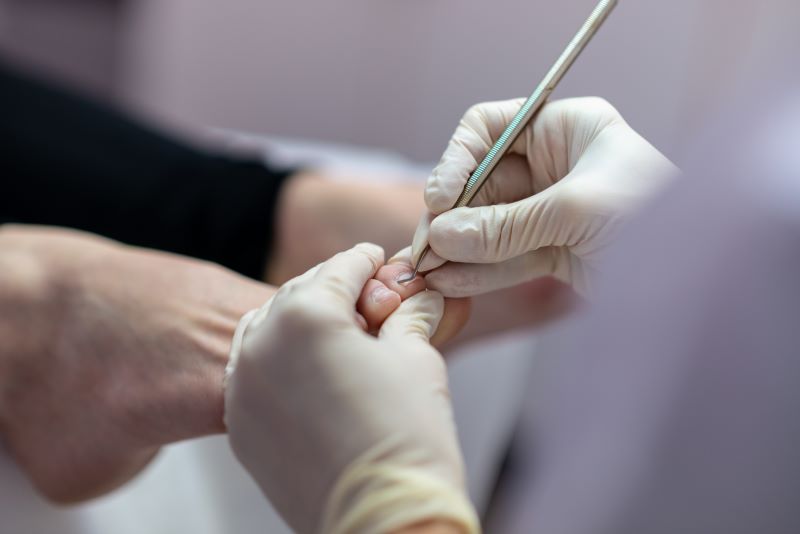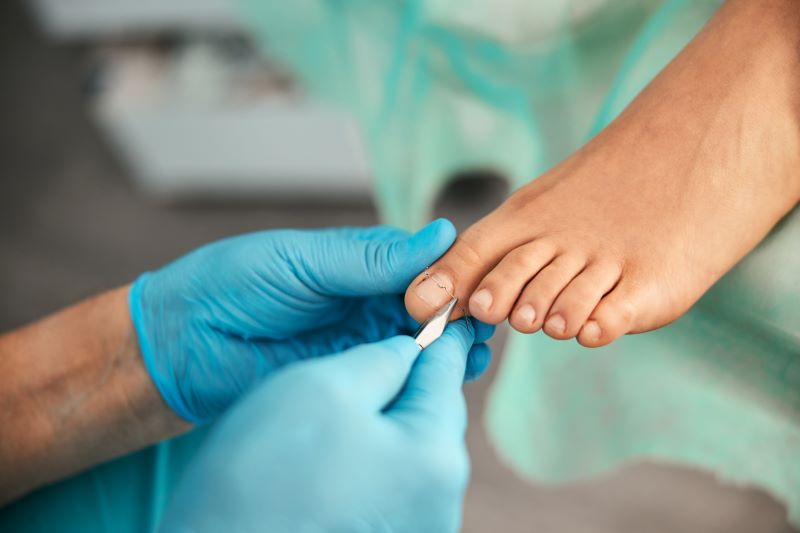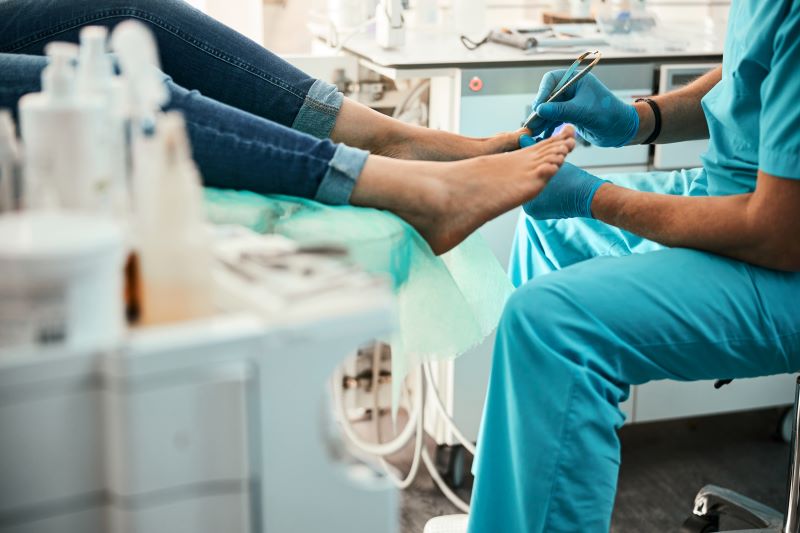After a long day, you sit down to take your shoes off to get relief but your big toe keeps hurting. You take a closer look, and you see that the skin around your big toe’s nail bed is red, swollen, and tender to the touch. It is most likely an ingrown toenail. Ingrown toenails are a common cause of foot pain. Let’s face it: an ingrown toenail is painful, and for some people, perhaps a little embarrassing. However, we see tons of clients with this condition every year! The best thing you can do about an ingrown toenail is to seek treatment at the Foot & Ankle Specialists of Illinois. We have several methods of treating ingrown toenails to help you recover in very little time. Don’t live with the pain and discomfort of an ingrown toenail any longer.
 What is an Ingrown Toenail?
What is an Ingrown Toenail?
An ingrown toenail is when the side or corner of your nail curls down and digs (probably painfully) into the skin of your toe. Ingrown toenails are most common on the big toe, but they can happen on any toenail. The pain from an ingrown toenail can make it difficult to walk or even stand.
Symptoms of an Ingrown Toenail
Some of the common ingrown toenail symptoms include redness, swelling, and pain on the toe around your nail.
Causes of an Ingrown Toenail
Are you not sure why you have developed an ingrown toenail? There are several potential causes of ingrown toenails, including wearing shoes that do not fit well, improperly trimming your nails, and an injury to your toe. People who have misshapen or deformed toenails are at a higher risk of developing ingrown toenails.
Are Ingrown Toenails Common?
Ingrown toenails are extremely common. In fact, 20 out of 100 people who see their family doctor because of foot problems have an ingrown toenail, according to the National Center for Biotechnology Information. Anyone can get an ingrown toenail, though they are more common in:
- Teenagers and young adults
- Athletes
- Diabetics
- People who have severe nerve damage in their legs or feet
- Anyone with poor blood circulation
- People with infections around their toenails
What Should I Do About an Ingrown Toenail?
Just because ingrown toenails are a common foot issue does not mean that they are not serious. Do you have a nail that you are worried is ingrown or is starting to be painful? Then, it’s time to see a doctor, like the ones at Foot & Ankle Specialists of Illinois. An ingrown toenail will not heal by itself and it could worsen and even become infected.
 Home Ingrown Toenail Treatment Options
Home Ingrown Toenail Treatment Options
Though it is important to seek ingrown toenail treatment from a medical professional, there are some ways to treat an ingrown toenail at home, including:
- Soak your feet: Try soaking your affected foot in warm, soapy water for 10 to 20 minutes, three to four times each day, until the nail improves. Keep the foot dry the rest of the day.
- Put cotton or floss under your toenail: After you soak your foot, place some waxed dental floss or small pieces of cotton under the ingrown edge. This helps the nail grow above the skin’s edge.
- Try petroleum jelly: Put a product containing petroleum jelly (like Vaseline) on the sore area and put a bandage over it.
- Choose the right shoes: Wear open-toed shoes, like sandals, until your toe feels better.
- Take over-the-counter pain relievers: Try taking acetaminophen or ibuprofen to ease the toe pain.
Ingrown Toenail Removal
If home remedies haven’t improved your ingrown toenail, it’s time to see a medical provider, like the experts at Foot & Ankle Specialists of Illinois. We offer multiple different treatments for ingrown toenail removal. There are two different main techniques. One involves chemical intervention, and the other does not. At your consultation, your surgeon will decide which procedure is best for you.
If you need to have surgery to remove your ingrown toenail, it involves removing a small portion of the side of the nail and destroying the nail bed below. The toe is injected with numbing medicine, and the toenail is cut to create a new, straight nail edge.
Partial Nail Avulsion Without Chemical Matrixectomy
A partial nail avulsion (a fancy way of saying removal) without chemical matrixectomy is also known as a temporary removal of the involved nail plate. Typically, this procedure happens in our office while you are under a local anesthetic. The involved nail border will be removed, without disturbing the nail matrix. The nail border could become infected and it could even become infected again in the future.
Partial Nail Avulsion With Chemical Matrixectomy
The same nail removal can be performed, except with phenol. Phenol is a powerful and potent chemical that we introduce into the nail matrix in order to permanently destroy the cells that will allow for nail growth and for you to potentially suffer from another ingrown toenail in the future.
Recovery from Ingrown Toenail Surgery
Many patients have questions about recovery after ingrown toenail surgery. Most people are back in normal shoes and resuming full activities within two weeks of the procedure.
 Tips to Avoid Ingrown Toenails in the Future
Tips to Avoid Ingrown Toenails in the Future
In order to avoid the recurrence of an ingrown toenail, when you are trimming your toenails, cut them straight across. The top of your nail should be a straight line. Try to avoid picking at your nails or tearing them at the corner. Also, always wear shoes that fit correctly and are not too tight. If possible, avoid high heels. It is important to always take good care of your feet.
Get Treatment for Your Ingrown Toenail at Foot & Ankle Specialists of Illinois
If you are still wondering, “what should I do about an ingrown toenail?” It’s easy! Simply give us a call. At Foot & Ankle Specialists of Illinois, we are the ingrown toenail specialists who have helped patients with ingrown toenails in Huntley, BArrington, and Hoffman Estates. We see ingrown toenails nearly every day and can help remove your ingrown toenail and help you prevent them from happening again in the future. Contact us today to set up an ingrown toenail consultation.

